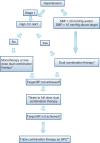Current perspectives on combination therapy in the management of hypertension
- PMID: 23837009
- PMCID: PMC3699293
- DOI: 10.2147/IBPC.S33985
Current perspectives on combination therapy in the management of hypertension
Abstract
Hypertension (HTN) is a worldwide health problem and a major preventable risk factor for cardiovascular (CV) events. Achieving an optimal blood pressure (BP) target for patients with HTN will often require more than one BP-lowering drug. Combination therapy is not only needed, but also confers many advantages such as better efficacy and a better tolerability. A better compliance and simplicity of treatment is noted with the single-pill combination (SPC). In addition, for those patients who do not achieve BP target when receiving dual combinations, triple SPCs are now available, and their efficacy and safety have been tested in large clinical trials. BP-lowering drugs used in combination therapy should have complementary mechanisms of action, leading to an additive BP-lowering effect and improvement in overall tolerability, achieved by decreasing the incidence of adverse effects. On the basis of large, outcome-driven trials, preferred dual combinations include an angiotensin receptor antagonist (ARB) or an angiotensin converting enzyme inhibitor (ACEI) combined with a calcium channel blocker (CCB), or an ARB or ACEI combined with a diuretic. Acceptable dual combinations include a direct rennin inhibitor (DRI) and a CCB, a DRI and a diuretic, a beta-blocker and a diuretic, a CCB and a diuretic, a CCB and a beta-blocker, a dihydropyridine CCB and a non-dihydropyridine CCB, and a thiazide diuretic combined with a potassium-sparing diuretic. Some combinations are not recommended and may even be harmful, such as dual renin angiotensin aldosterone system inhibition. Currently available triple SPCs combine a renin angiotensin aldosterone system inhibitor with a CCB and a diuretic. Combination therapy as an initial approach is advocated in patients with a systolic BP more than 20 mmHg and/or a diastolic BP more than 10 mmHg above target and in patients with high CV risk. In addition, using SPCs has been stressed and favored in recent international guidelines. Recently, triple SPCs have been approved and provide an attractive option for patients not achieving BP target on dual combination. The effect of such a strategy in the overall management of HTN, especially on further reducing the incidence of CV events, will have to be confirmed in future clinical and population-based studies.
Keywords: combination therapy; dual combination; hypertension; single pill; triple combination.
Figures

References
-
- Kearney PM, Whelton M, Reynolds K, Muntner P, Whelton PK, He J. Global burden of hypertension: analysis of worldwide data. Lancet. 2005;365(9455):217–223. - PubMed
-
- Centers for Disease Control and Prevention (CDC) Vital signs: prevalence, treatment, and control of hypertension – United States, 1999–2002 and 2005–2008. MMWR Morb Mortal Wkly Rep. 2011;60(4):103–108. - PubMed
-
- Levy D, Larson MG, Vasan RS, Kannel WB, Ho KK. The progression from hypertension to congestive heart failure. JAMA. 1996;275(20):1557–1562. - PubMed
-
- Criqui MH, Langer RD, Fronek A, et al. Mortality over a period of 10 years in patients with peripheral arterial disease. N Engl J Med. 1992;326(6):381–386. - PubMed
LinkOut - more resources
Full Text Sources
Other Literature Sources

